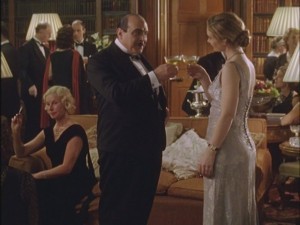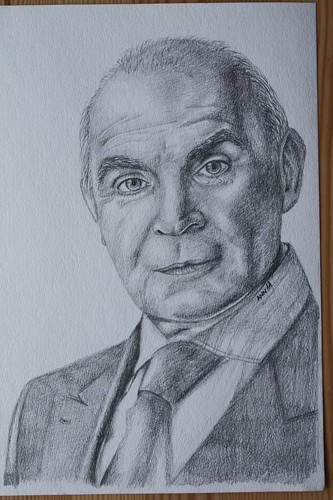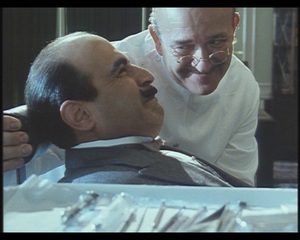"THREE ACT TRAGEDY" (2010) Review
When I was in my early teens, I had shifted my attention from Nancy Drew mysteries to those novels written by Agatha Christie. And I have not stopped since. I confess that this shift in reading material was the result of seeing the 1978 movie, "DEATH ON THE NILE", for the first time. Properly hooked on Christie's works, I focused my attention on her 1934 novel, "Murder in Three Acts", also known as "Three Act Tragedy".
I have seen two adaptations of Christie's 1934 novel. The first was television adaptation in the mid 1980s, titled "MURDER IN THREE ACTS", which starred Christie veteran Peter Ustinov as Hercule Poirot. Although I enjoyed it, I had hoped to see an adaptation of the novel in its original 1930s setting. I had to wait many years before the ITV series, "AGATHA CHRISTIE'S POIROT" granted my wish with an adaptation that not only retained the original setting, but also the original title, "THREE ACT TRAGEDY".
The story begins on the coast of Cornwall, where Hercule Poirot attends a dinner party at the home of famed stage actor, Sir Charles Cartwright. The latter's guests also include:
*Dr. Sir Bartholomew Strange - Sir Charles' old childhood friend and a nerve specialist
*Lady Mary Lytton-Gore - a Cornish neighbor of Sir Charles, who is from an impoverished old family
*Hermione "Egg" Lytton-Gore - Lady Mary's young daughter, with whom Sir Charles is in love
*Muriel Wills - a successful playwright also known as Anthony Astor
*Captain Freddie Dacres - a former Army officer and gentleman gambler
*Cynthia Dacres - Captain Dacres' wife and a successful dressmaker
*Reverend Stephen Babbington - the local curate and Sir Charles' Cornish neighbor
*Mrs. Babbington - Reverend Babbington's wife near Sir Charles's home in Cornwall.
*Oliver Manders - a young Cornish neighbor of Sir Charles', who is interested in Egg
*Miss Milray - Sir Charles' secretary
The guests gather in Sir Charles' drawing-room for a round of pre-dinner cocktails. The party is marred when one of the guests, Reverend Babbington, collapses and dies after drinking his cocktail. An inquest rules his death as a result from natural causes. However, Sir Charles believes that Reverend Babbington may have been murdered, but Poirot is not convinced. About a month or so later, Poirot is vacationing in Monte Carlo, when he encounters Sir Charles. The latter reveals via a newspaper article that Dr. Strange had died from similar circumstances, while hosting a dinner party at his home in Yorkshire. Most of the guests who had attended Sir Charles' party had also been there, with the exception of Mrs. Babbington and Miss Milray. Unlike Reverend Babbington, Sir Bartholomew's death has been ruled as a homicide. Both Poirot and Sir Charles return to Britain to investigate the two deaths.
Although "Three Act Tragedy" was one of the first Christie novels I had read, it has never been a favorite of mine. I liked it, but I did not love it. Screenwriter Nick Dear made some changes to the story that I either found appropriate or did not bother me. Dear removed characters like society hound like Mr. Satterthwaite and stage actress Angela Sutcliffe (and one of Sir Charles' former lovers). I did not miss them. One change really improved the story for me. One aspect of the novel that I found particularly frustrating was the minimized presence of Poirot. The lack of Poirot almost dragged the novel into a halt. Thankfully, Dear avoided this major flaw by allowing Poirot's presence to be a lot more prominent. He achieved this change by making Poirot a friend of Sir Charles and removing the Mr. Satterthwaite. Dear also made one other major change in Christie's story, but I will get to it later.
Visually, "THREE ACT TRAGEDY" is a gorgeous movie to watch. Peter Greenhalgh, who had passed away last year, provided the production with a colorful photography that I found particularly beautiful. My only complaint about Greenhalgh's photography is that it struck me as a little fuzzy at times to indicate the story's presence in the past. Another dazzling aspect of "THREE ACT TRAGEDY" were the production designs created by Jeff Tessler, who more orless served as the production designer for "AGATHA CHRISTIE'S POIROT" between 2005 and the series' end in 2013. Judging by the admirable way he managed to re-create not only the movie's 1930s setting, but also various locations, only tells me that he had been doing something write. I certainly had no complaints about the costumes designed by Sheena Napier. Like Tessler, she worked for "AGATHA CHRISTIE'S POIROT" for a long period of time . . . even longer than Tessler. Although I am no expert on early 20th century fashion, I thought Napier excellent job in creating costumes for the production's setting and the different characters.
The performances featured in "THREE ACT TRAGEDY" were first-rate. I did not find anything exceptional about David Suchet's portrayal of Hercule Poirot, but I thought he gave his usual more-than-competent performance. Martin Shaw gave a very solid performance as the charming, yet intelligent Sir Charles Cartwright, who was the first to sense something wrong about the first murder. I was also impressed by how the actor conveyed his character's insecurity over a romance with a much younger woman. Kimberly Nixon seemed like a ball of fire, thanks to her portrayal of the vibrant and charming Egg Lytton-Gore, who found herself torn between two men. I also enjoyed Art Malik's portrayal of the extroverted Dr. Sir Bartholomew Strange. Although there were times when his performance struck me as a touch too jovial. Ronan Vibert gave a rather insidious, yet oddly charming performance as "gentleman" gambler Captain Freddie Dacres. The one performance that really impressed me came Kate Ashfield who gave a very interesting performance as playwright Anthony Astor aka Miss Muriel Wills. Ashfield did an excellent job in recapturing Miss Wills' secretive, yet uber observant personality. The production also featured solid performances from Anastasia Hille, Tom Wisdom, Anna Carteret, Suzanne Bertish, and Tony Maudsley.
I do have a complaint about "THREE ACT TRAGEDY". I really wish that Nick Dear had not changed the murderer's main motive for the killings. I have heard rumors that there are two different versions of the story's resolution. My literary version of "THREE ACT TRAGEDY" questioned the murderer's sanity, making the murders a lot more interesting to me. Unfortunately, Nick Dear used the other resolution, one that struck me as a lot more mundane and not very interesting. Too bad.
Aside from changing the killer's motive for the murders, I rather enjoyed "THREE ACT TRAGEDY". I am thankful that screenwriter Nick Dear had made Hercule Poirot's presence in the story more prominent than it was in the novel. After all, he is the story's main investigator. But despite excellent acting and solid direction by Ashley Pearce, I would never regard it as one of my favorite productions from "AGATHA CHRISTIE'S POIROT". It was simply a pretty good adaptation of a solid Christie novel. There is nothing else for me to say.
When I was in my early teens, I had shifted my attention from Nancy Drew mysteries to those novels written by Agatha Christie. And I have not stopped since. I confess that this shift in reading material was the result of seeing the 1978 movie, "DEATH ON THE NILE", for the first time. Properly hooked on Christie's works, I focused my attention on her 1934 novel, "Murder in Three Acts", also known as "Three Act Tragedy".
I have seen two adaptations of Christie's 1934 novel. The first was television adaptation in the mid 1980s, titled "MURDER IN THREE ACTS", which starred Christie veteran Peter Ustinov as Hercule Poirot. Although I enjoyed it, I had hoped to see an adaptation of the novel in its original 1930s setting. I had to wait many years before the ITV series, "AGATHA CHRISTIE'S POIROT" granted my wish with an adaptation that not only retained the original setting, but also the original title, "THREE ACT TRAGEDY".
The story begins on the coast of Cornwall, where Hercule Poirot attends a dinner party at the home of famed stage actor, Sir Charles Cartwright. The latter's guests also include:
*Dr. Sir Bartholomew Strange - Sir Charles' old childhood friend and a nerve specialist
*Lady Mary Lytton-Gore - a Cornish neighbor of Sir Charles, who is from an impoverished old family
*Hermione "Egg" Lytton-Gore - Lady Mary's young daughter, with whom Sir Charles is in love
*Muriel Wills - a successful playwright also known as Anthony Astor
*Captain Freddie Dacres - a former Army officer and gentleman gambler
*Cynthia Dacres - Captain Dacres' wife and a successful dressmaker
*Reverend Stephen Babbington - the local curate and Sir Charles' Cornish neighbor
*Mrs. Babbington - Reverend Babbington's wife near Sir Charles's home in Cornwall.
*Oliver Manders - a young Cornish neighbor of Sir Charles', who is interested in Egg
*Miss Milray - Sir Charles' secretary
The guests gather in Sir Charles' drawing-room for a round of pre-dinner cocktails. The party is marred when one of the guests, Reverend Babbington, collapses and dies after drinking his cocktail. An inquest rules his death as a result from natural causes. However, Sir Charles believes that Reverend Babbington may have been murdered, but Poirot is not convinced. About a month or so later, Poirot is vacationing in Monte Carlo, when he encounters Sir Charles. The latter reveals via a newspaper article that Dr. Strange had died from similar circumstances, while hosting a dinner party at his home in Yorkshire. Most of the guests who had attended Sir Charles' party had also been there, with the exception of Mrs. Babbington and Miss Milray. Unlike Reverend Babbington, Sir Bartholomew's death has been ruled as a homicide. Both Poirot and Sir Charles return to Britain to investigate the two deaths.
Although "Three Act Tragedy" was one of the first Christie novels I had read, it has never been a favorite of mine. I liked it, but I did not love it. Screenwriter Nick Dear made some changes to the story that I either found appropriate or did not bother me. Dear removed characters like society hound like Mr. Satterthwaite and stage actress Angela Sutcliffe (and one of Sir Charles' former lovers). I did not miss them. One change really improved the story for me. One aspect of the novel that I found particularly frustrating was the minimized presence of Poirot. The lack of Poirot almost dragged the novel into a halt. Thankfully, Dear avoided this major flaw by allowing Poirot's presence to be a lot more prominent. He achieved this change by making Poirot a friend of Sir Charles and removing the Mr. Satterthwaite. Dear also made one other major change in Christie's story, but I will get to it later.
Visually, "THREE ACT TRAGEDY" is a gorgeous movie to watch. Peter Greenhalgh, who had passed away last year, provided the production with a colorful photography that I found particularly beautiful. My only complaint about Greenhalgh's photography is that it struck me as a little fuzzy at times to indicate the story's presence in the past. Another dazzling aspect of "THREE ACT TRAGEDY" were the production designs created by Jeff Tessler, who more orless served as the production designer for "AGATHA CHRISTIE'S POIROT" between 2005 and the series' end in 2013. Judging by the admirable way he managed to re-create not only the movie's 1930s setting, but also various locations, only tells me that he had been doing something write. I certainly had no complaints about the costumes designed by Sheena Napier. Like Tessler, she worked for "AGATHA CHRISTIE'S POIROT" for a long period of time . . . even longer than Tessler. Although I am no expert on early 20th century fashion, I thought Napier excellent job in creating costumes for the production's setting and the different characters.
The performances featured in "THREE ACT TRAGEDY" were first-rate. I did not find anything exceptional about David Suchet's portrayal of Hercule Poirot, but I thought he gave his usual more-than-competent performance. Martin Shaw gave a very solid performance as the charming, yet intelligent Sir Charles Cartwright, who was the first to sense something wrong about the first murder. I was also impressed by how the actor conveyed his character's insecurity over a romance with a much younger woman. Kimberly Nixon seemed like a ball of fire, thanks to her portrayal of the vibrant and charming Egg Lytton-Gore, who found herself torn between two men. I also enjoyed Art Malik's portrayal of the extroverted Dr. Sir Bartholomew Strange. Although there were times when his performance struck me as a touch too jovial. Ronan Vibert gave a rather insidious, yet oddly charming performance as "gentleman" gambler Captain Freddie Dacres. The one performance that really impressed me came Kate Ashfield who gave a very interesting performance as playwright Anthony Astor aka Miss Muriel Wills. Ashfield did an excellent job in recapturing Miss Wills' secretive, yet uber observant personality. The production also featured solid performances from Anastasia Hille, Tom Wisdom, Anna Carteret, Suzanne Bertish, and Tony Maudsley.
I do have a complaint about "THREE ACT TRAGEDY". I really wish that Nick Dear had not changed the murderer's main motive for the killings. I have heard rumors that there are two different versions of the story's resolution. My literary version of "THREE ACT TRAGEDY" questioned the murderer's sanity, making the murders a lot more interesting to me. Unfortunately, Nick Dear used the other resolution, one that struck me as a lot more mundane and not very interesting. Too bad.
Aside from changing the killer's motive for the murders, I rather enjoyed "THREE ACT TRAGEDY". I am thankful that screenwriter Nick Dear had made Hercule Poirot's presence in the story more prominent than it was in the novel. After all, he is the story's main investigator. But despite excellent acting and solid direction by Ashley Pearce, I would never regard it as one of my favorite productions from "AGATHA CHRISTIE'S POIROT". It was simply a pretty good adaptation of a solid Christie novel. There is nothing else for me to say.










